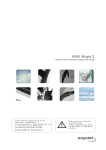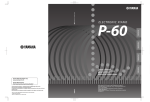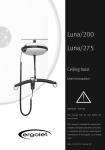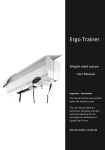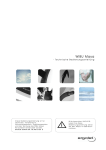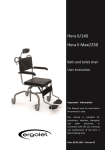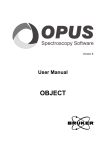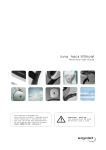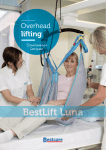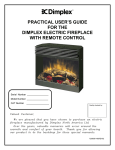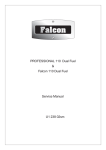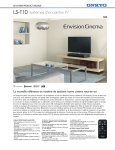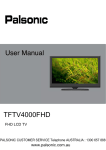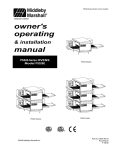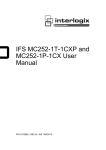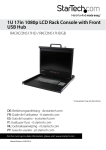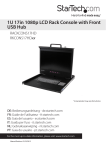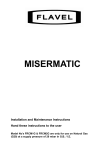Download Solar 175 Mobile lift User Manual
Transcript
Solar/175 Mobile hoist User instruction Important information This user instruction must be read before the mobile hoist is used. This user instruction is intended for technicians, installers, therapists and other personnel, in connection with the use, servicing and maintenance of the mobile hoist. Scan the QR-code for further information Date: 09.01.2013 - Version 03 2 Contents 1. Aim and use 1.1 1.2 1.3 1.4 1.5 1.6 1.7 Purpose Safety instructions Before use Terminology Unpacking Assembling instruction Spreader bar and lifting slings 4 4 5 5 6 6 8 2.1 2.2 2.3 2.4 2.5 Pictograms and functions – control box Pictograms and functions – hand control Safety functions Charging Transport 9 10 11 12 12 3.1 3.2 Using the mobile hoist Using the control box 13 13 Cleaning Storage 14 14 2. Functions 3. Use 4. Maintenance 4.1 4.2 5. Check and troubleshooting 5.1 5.2 Annual check Troubleshooting 14 15 6. Technical data and dimensions 6.1 6.2 Technical specifications Dimensions 16 17 7. Environment and quality 7.1 7.2 7.3 7.4 Disposal Battery Quality Symbols and abbreviations 18 18 18 19 8. Accessories 20 3 1. Aim and use 1.1 Purpose Solar/175 is a mobile hoist designed to transfer persons in institutions such as nursing homes, hospitals, care centres and in home care. Solar can be used for transfer between bed and chair/wheelchair, from chair to another chair and from chair to a toilet. Solar is approved to transfer with a maximum load of 175 kg. The use of the Solar requires the following instructions: Personnel have received qualified instruction by Ergolet in using the mobile hoist. The mobile hoist has been assembled correctly and according to the user instruction. NEVER use the mobile hoist for other purposes than described in this user instruction. Persons, who are transferred, must not be squeezed or trapped in the lifting situation. The mobile hoist has been developed for use with Ergolet lifting slings and other sling products authorized by Ergolet. See Ergolet’s user instruction for slings for specific information about which models can be used. The mobile hoist is intended for indoor use under normal temperatures (+2 – +40 C°) and relative humidity (40-90%). 1.2 Safety instructions ! Important – Warning! This user instruction must be read thoroughly before the mobile hoist is taken into use. All parts must be mounted correctly according to this user instruction. There must be no indication of wear and tear on the mobile hoist or the lifting sling. NEVER begin lifting if there is suspicion of any defect (abnormal sound, loose brackets etc.). In such cases it is important to find the cause of the problem and take the mobile hoist out of service. Contact your dealer or Ergolet. The lifting capacity is 175 kg and must NEVER be exceeded. When using the mobile hoist in connection with other components e.g. slings it is always the component with the LOWEST weight capacity that decides the maximum lifting capacity. Ensure that neither carers/helpers nor patients/users can be hurt during the lifting. Never lift higher than necessary in the actual lifting situation. See section 5.1 (annual check) for further information. 4 1.3 Before use The carer/helper is responsible for ensuring that a daily check is carried out BEFORE the mobile hoist and accessories are used, including the following: Check that the mobile hoist is complete and no parts are missing. Check that there are no signs of rust, wear and tear or other defects. If there is any sign of a defect the mobile hoist must be taken out of use. Check the key functions, up/down and the leg adjustment are working on both the control box and the hand control. If the checks or the use of the hoist generate unusual noises, then the hoist must not be used before a qualified technician has carried out a safety check on the hoist. Check the lifting slings for any damages especially as regards to the lifting straps for tears in the material. The slings must not be used if defects are detected. If in any doubt concerning the use of mobile hoist or lifting slings, contact Ergolet for advice and guidance. 1.4 Terminology Lifting arm Spreader bar Hand control Handles Control box, emergency stop and battery Actuator Mast Leg Base for electrical leg spreading Fig. 1.4 5 1.5 Unpacking Check that all the parts are present and undamaged. Any suspicion of damage or shortage should be reported to your dealer or Ergolet. We recommend that the box packaging is kept if the mobile hoist is to be used on other sites or for return shipment in case of repair or annual check. Content of the box: 1. 2. 3. 4. 5. 6. 7. 8. 9. Leg with base for leg spreading Mast and lifting arm with spreader bar Actuator Hand control Control box Handles Battery Tools (Allen key, spanner) User instruction 1.6 Assembling instruction Following step by step the assembling guidance: 1. Place the leg part on the floor and brake the wheels. (Fig. 1.6A) 2. Assembly the mast/lifting arm with the leg part and tighten the hand screw. (Fig. 1.6B + 1.6C) Fig. 1.6B 6 Fig. 1.6A Fig. 1.6C 3. Assembly the actuators piston rod to the lifting arm. Use the Allen key and the spanner to tighten the bolt/nut. (Fig. 1.6D). Put the cap on the nut. Fig. 1.6D 4. Assembly the handles on the mast with a screw and tighten with the Allen key. (Fig 1.6E) Fig. 1.6E 5. The hand control, lifting arm and electrical leg spreader are connected to the control box. (Fig 1.6F) (See section 2.1 – functions / connection). Fig. 1.6F 7 1.7 Spreader bar and lifting slings The mobile hoist is equipped with a spreader bar, which is designed for use with Ergolet lifting slings. Ergolet´s lifting slings have 4-6 lifting straps and are designed for lifting hooks larger than ø8mm. If using non-authorized slings, Ergolet will have no responsibility for faults or accidents. Ergolet can assist in choosing the correct sling and also offers training sessions in transfer techniques and the correct use of slings. Hanging slings on the Ergolet spreader bar. Ergolet accepts no responsibility if slings are attached incorrectly, it is always the onus of the carer/helper to ensure that the sling is correct for the situation needs and is correctly mounted. (1) The sling strap is placed over the hook in its open position. (Fig. 1.7A) (2) The strap is pulled downwards so that the hook locks. (Fig. 1.7B) (1) The design of the lifting hook is that the weight of the patient/user helps to close the hook. To release the strap after lifting simply pull upwards to open the hook. Fig. 1.7A (2) Fig. 1.7B Note: Risk of finger entrapment - ensure that user’s fingers cannot get trapped. 8 2. Functions 2.1 Pictograms and functions – control-box (1) Connecting plug - hand control (2) Connecting plug - lifting actuator (5) (3) Connecting plug - electrical leg spreading (4) Connecting plug - power supply (5) Battery (6) Emergency stop – See section 2.3 (7) Lift up/down – Press and the lifting arm is lifted up. Press and the lifting arm is lowered. Stop movement by releasing the button. (6) (7) (8) (9) (10) (11) (8) Leg spreading in/out – Press and the leg spreading move together. Press and the leg spreading will spread. Stop movement by releasing the button. (9) Charge – indicates charging on the battery (see section 2.4) (10) ON – indicates that main supply is on. (1) (2) (3) (4) (11) Display – (See section 3.2) 9 2.2 Pictograms and functions – hand control (1) Turtle – This function operates the lifting arm up/down in a low speed. (1) (2) (3) (2) Max Kg – indicates an overload (see section 3.2) (3) Hare – This function operates the lifting arm up/down in a high speed. (4) (4) Leg spreading – Press and the leg spreading moves together. Press and the leg spreading will spread outwards. (5) (5) Service – See section 3.2 (6) (6) Battery – indicates the state of the battery (see section 2.4) 10 2.3 Safety functions Emergency stop: This function is only to be used in an emergency e.g. if the mobile hoist does not react or does not stop after pressing a button on the hand control. If the emergency button has been activated all functions immediately stop. The emergency stop can be released by turning the red button a ¼ turn to the right. (Fig 2.3A) Fig. 2.3A Emergency lowering: This function is only to be used in an emergency, where it is necessary to safely lower a patient. The emergency lowering is placed on the lifting actuator, and is activated by pulling the red handle upwards, so the lifting arm is slowly lowered. (Fig 2.3B) Fig. 2.3B Applies for both functions: If the emergency button/lowering handle has been activated due to an emergency, the mobile hoist must not be used again before a check has been made and any defect repaired. In any doubt, please contact Ergolet. 11 2.4 Charging The mobile hoist is equipped with a battery that requires regular charging. Ergolet recommends that the battery is charged when the mobile hoist is not in use or every night. The mobile hoist can be charged from the mains (wall outlet). There are 3 batteries symbols on the hand control, which indicate the power level in the battery. Low battery The battery must IMMEDIATELY be put on charge. In this situation remain on charge for 24 hours. Battery 25% An audible battery alarm will alert, when there is a 25% capacity remaining in the battery. Battery 50% Recommend charging to avoid low battery. Full battery The hoist is ready for use. Note: The mobile hoist cannot be overcharged. Charge directly from the wall outlet 1) Remove the plug, placed on the side of the control box and plug into the mains. 2) The cable from the charger to the mains must be loose. 3) On the control box there is a diode, that lights yellow, and the display shows a plug symbol during charging. 2.5 Transport The mobile hoist is most safely transported using the original packing. Symbols are printed on the packaging to ensure the best information to carrier companies. 12 3. Use 3.1 Using the mobile hoist Solar/175 is ready for use if all assembly instructions have been followed. Operation of the mobile hoist when turning: To turn the mobile hoist with the patient, it is important that the carer is turn ergonomically around. Sometimes it can be a help to brake one of the wheels. 3.2 Using the control box Display information’s: To activate the display, press up and down at the same time on the hand control. Total cycles – lifting actuator Total work Number of overloads Day since last service/days between services Service indicator: When it is time for a service on the lifting actuator the diode lights on the hand control and this symbol will be shown on the display. Service interval is set to 8000 cycles/12 months by default, but can be adjusted by a service technician. Resetting of service is done by pressing up/down on the hand control at the same time for 5 sec. The timer will reset and start counting a new service period. Overload: The safety working loads (SWL) is 175 kg and has been exceeded. Charge: See description in section 2.4 Battery: See description in section 2.4. 13 4. Maintenance 4.1 Cleaning The mobile hoist may be cleaned using a slightly damp cloth with a standard household cleaning agent. Chemicals and other strong/abrasive agents must not be used. It is recommended that the mobile hoist be cleaned after each use to avoid infection. The mobile hoist can be disinfected with household alcohol. 4.2 Storage The mobile hoist must be stored in a dry environment with relative humidity under 90%. If the mobile hoist is not to be used over a longer period of time it is best to fully charge the unit and activate the emergency button to save battery before putting in storage. 5. Check, service data and troubleshooting 5.1 Annual check The manufacturer Ergolet stipulates that this hoist MUST be checked by a qualified and authorised person at least once a year. This annual check is also recommended in the Standard (EN/ISO 10535) for lifters/hoists. It is the customer to ensure that the annual check is carried out. Scheduled maintenance and replacement of parts must always be carried out by authorised persons, who have been approved by Ergolet. If it is necessary to replace any parts due to wear or damage these must be obtained/purchased from Ergolet. Warranty 2 years warranty against manufacturing or material defects. For more information contact Ergolet. 14 5.3 Troubleshooting Fault: The hoist does not react when the hand control buttons UP/DOWN are used. Possible cause: Emergency stop is activated. Solution: Possible cause: Solution: Release the emergency stop (see section 2.3) Defect hand control. Try using another hand control. Alternative is to get a new hand control from the dealer. Flat battery. Charge battery (see section 2.4). Possible cause: Solution: Fault: The lifting arm can travel up or down not both. The electrical leg spreading can only move in or out not both. Fault: The lifting actuator is noisy or vibrates abnormally Fault: Does not charge Possible cause: Solution: Possible cause: Solution: Fault in the control box. Replace the control box. Defect hand control. Try using another hand control. Alternative is to get a new hand control from the dealer. Possible cause: Solution: Lifting actuator is defect. Replace the lifting actuator. Possible cause: Solution: Possible cause: Solution: Charger is not connected to the main supply. Connect charger. Defect control box. Try another control box. Order a new from Ergolet or the dealer. Defect battery. Replace battery. Possible cause: Solution: 15 6. Technical data and dimensions 6.1 Technical specifications Lifting properties: Load capacity: Number of lift movements: Duty cycle: Manually emergency lowering: Electronically lowering: 175 kg 40-60 with 80kg / 0,5 m lift 10%, max, 2 min/18 min Yes Yes Electrical details: Power supply (Input): Output voltage: Control box (Output): Battery capacity: 100-240 VAC 50/60 Hz, max 0,35 A 24V 250 VA 2,9Ah IP-class: IPX4 Noise: Lwa during lifting/lowering without load is 52dB(A) Lwa during lifting/lowering at maximum load is 48dB(A) Material: Powder coated steel More test results may be available by contacting Ergolet. 16 6.2 Dimensions 1. 2. 3. Highest point Maximum reach point Lowest position a) Max. reach at 600 mm (reference height): b) Max. reach from base: c) Reach from base with legs spread to 700 mm: d) Min. Dist. from wall to CSP* at max. height (legs spread): e) Min. Dist. from wall to CSP* at max. reach (legs spread): f) Min. Dist. from wall to CSP* at min. height (legs spread): k) l) m) p) q) Max. height of CSP *: Min. Height of CSP*: Hoisting range: Max. internal width: Internal width at max. reach: r) Min. internal width: 614mm 674mm 200mm 538mm 217mm 439mm 1970mm 636mm 1342mm 920mm 893mm 550mm * Central suspensions point Turning diameter: 1430mm Weight: Weight in total: 50 kg Mast incl. battery: 26 kg (battery 2,8kg) Base/legs: 24 kg 17 7. Environment and quality Solar has an expected life time of minimum 10 years under the assumption that all recommended service checks have been carried out and that the normal maintenance and care instructions have been followed. 7.1 Disposal Disposal of this mobile hoist can be made through Ergolet. After useful lifetime Ergolet will receive the mobile hoist back and split the individual fractions in an environmentally friendly way either through reuse or recycling. Fractions that contain aluminum, lead acid batteries, electrical component, ABS plastic, steel may damage the environment if not handled in an environmentally responsible way. 7.2 Battery The mobile hoist is equipped with one battery, which may be returned either to the local recycling station or to Ergolet at the end of their lifetime. 7.3 Quality Ergolet is certified according to the quality standard ISO 9001 and ISO 13485. These certifications mean that the products and the company complies with the international standards for quality management and standards for traceability of medical products. Solar/175 is classified as a Medical device class 1 product. 18 7.4 Symbols and abbreviations Direct current Double insulated The patient is not separated from the ground and the chassis The product should be reused where possible Refer to user instruction SWL Safe working load (user + sling) 19 8. Accessories Solar 010-01314EU 010-01314UK 010-01314US 010-01314AUS 010-01316EU 010-01316UK Solar/175 with 2 points spreader bar, 58 cm Solar/175 with 3 points spreader bar, 58 cm Hand control 018-08021 Standard hand control Standard spreader bar, Solar/175 kg 018-03505 018-03507 018-03503 58 cm spreader bar 48 cm spreader bar 36 cm spreader bar Spreader bar with weigh scale 017-00121 Weigh scale incl. spreader bar 3-points spreader bar 018-03510 3-points spreader bar 4-points spreader bar 018-03509 4-points spreader bar Battery 018-08014 Battery module, 24V Spare parts list can be ordered. Contact Ergolet for more information. 20 21 22 23 Manufacturer: Ergolet Taarnborgvej 12 C 4220 Korsoer Denmark Phone: + 45 70 27 37 20 Fax: + 45 70 27 37 19 Email: [email protected] www.ergolet.com 93/42/EØF CLASS I EN ISO 10535 910-00758UK 24
























